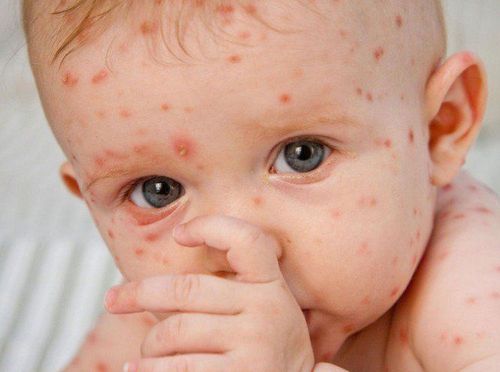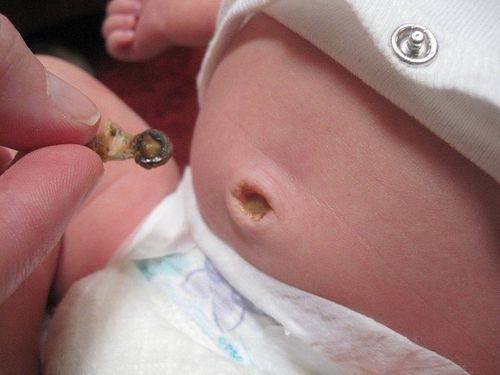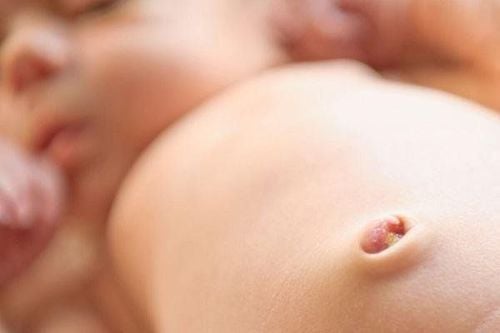This is an automatically translated article.
The article is expertly consulted by Master, Doctor Phan Thi Cam Van - Department of Pediatrics - Neonatology - Vinmec International General Hospital Da Nang. He has 07 years of experience as a Resident Doctor and a Pediatrician - Neonatal Doctor at Hue Central Hospital and Hue University Hospital of Medicine and Pharmacy. His strength is in treating pediatric diseases of respiratory, digestive, infectious diseases, newborn care and treatment, neonatal resuscitation.According to the statistics of the World Health Organization, up to 47% of newborns with sepsis have a transmission route from an umbilical cord infection and about 21% of newborns who come to the doctor for other reasons are accompanied by an infection. umbilical cord. Therefore, identifying and knowing how to take care of a child with an umbilical cord infection is an issue that parents should pay special attention to.
1. What is an umbilical cord infection in a newborn?
Neonatal infections include infections that can be acquired before birth, during delivery and 28 days after birth, including umbilical cord infection or umbilical cord infection. Umbilical infections can put you at risk for umbilical cord tetanus, one of the leading causes of infant death.Umbilical infection is an infection of the umbilical cord after birth, the infection can be localized to the umbilical cord site or spread, there is no longer a normal boundary between the skin and the umbilical cord mucosa, the narrowing area, the congested area spreads to Abdominal wall with edema, foul discharge, sometimes pus.
Some factors that cause umbilical cord infection in newborns are: Staphylococcus aureus bacteria from the skin to the navel, Gram (-) bacteria from the intestinal tract through feces causing infection to the umbilicus or bacteria. tetanus infection from non-sterile reproductive aids.
Trắc nghiệm: Thế nào là trẻ sơ sinh đủ tháng?
Đặc điểm bên ngoài của trẻ sơ sinh đủ tháng được thể hiện qua các tiêu chuẩn như: Cân nặng, chiều dài và hình thể. Theo dõi bài trắc nghiệm dưới đây sẽ giúp các bậc cha mẹ hiểu thế nào là trẻ sơ sinh đủ tháng, qua đó có thể đánh giá tổng trạng sức khỏe và sự phát triển của bé yêu nhà mình.The following content is prepared under supervision of Thạc sĩ, Bác sĩ y khoa, Ma Văn Thấm , Nhi , Phòng khám Đa khoa Quốc tế Vinmec Dương Đông(Phú Quốc)
2. Signs of neonatal umbilical cord infection
Right at the baby's umbilicus, red and swollen At the baby's navel area, there is a pus discharge with a foul smell or the umbilicus is still wet after shedding Redness of the skin around the navel The umbilicus is bleeding In addition, some Other accompanying signs such as: the child has a high fever over 38 degrees Celsius, the baby has rapid breathing (breathing rate over 60 times/minute), the baby has jaundice...

3. Risk of complications of umbilical cord infection
The umbilical cord is the way to move nutrients and oxygen from the mother's placenta to the fetus, and the umbilical cord is also connected directly to the baby's liver. Therefore, once the umbilical cord is infected, it will go to the liver very quickly, it can even enter the bloodstream and cause neonatal sepsis, especially the risk of death in babies is also very high (40-80%). ).Besides, if the umbilical cord infection occurs on the site of a baby born prematurely with low birth weight or occurs on the body of a baby born at home, the chances of the baby having umbilical cord tetanus are very high.
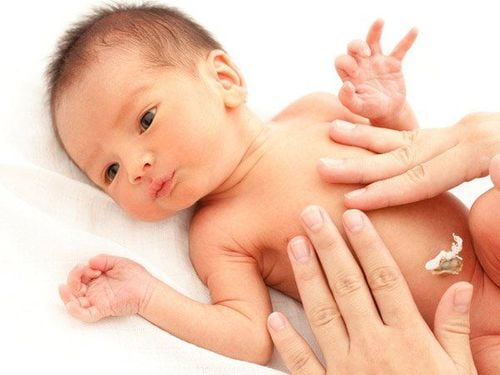
4. Classification of umbilical cord infection according to World Health Organization
Mild infection: The swelling and redness only occurs at the baby's umbilical cord foot. Moderate degree of umbilical infection: The degree of redness and swelling occurs at the base of the umbilicus and spreads around with a diameter of less than 2cm, accompanied by symptoms of fever, jaundice in newborns... Severe umbilical cord infection : The swelling, redness spreads more than 2cm and begins to necrosis down the muscle layer under the child's skin, along with symptoms of sepsis, septic shock.5. Hospitalization criteria
Mild: Children are given antibiotics in combination with local cleaning of the umbilical area with 70% alcohol solution Moderate: Newborns are required to be hospitalized for treatment with intravenous antibiotics intravenously, the treatment time can last about 7 days. Severity: The treatment takes place differently, not only using antibiotics to treat umbilical cord infections but also treating the symptoms of other accompanying diseases. Therefore, the duration of treatment will usually last more than 14 days.6. How to take care of a baby with an umbilical cord infection
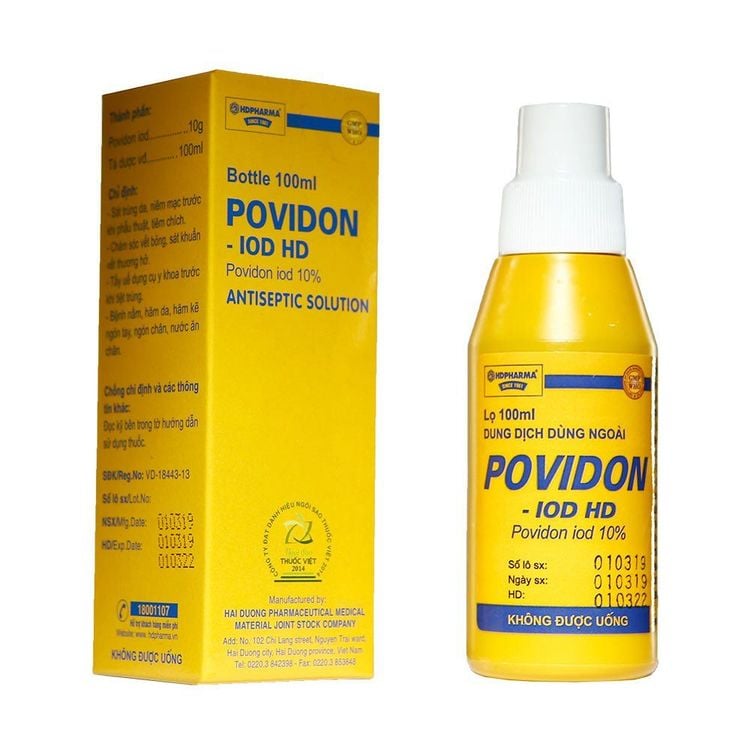
How to care for a baby with an umbilical cord infection applies to babies who have not lost the umbilical cord and also children who have lost the umbilical cord, the umbilical cord still has discharge or infection.
Preparation:
Disinfectant solution: alcohol 70 degrees or Povidone Iodine 2 - 3% Sterile tablets or cotton sticks, sterile gauze Sterile elastic cup Sterile pliers How to perform navel care:
Wash hands thoroughly . It is advisable to take care of the umbilical cord after bathing the baby. One hand uses sterile gauze to lift the umbilical cord, observe the umbilical cord, umbilical cord, umbilical cord and skin around the umbilicus, identify abnormalities such as: abundant discharge, blood, pus, skin around the navel red swelling... Using a sterile cotton swab soaked in an antiseptic solution, wipe the position around the umbilical stump, from the umbilical foot to the umbilical cord, the umbilical cord clamping position and the umbilical cord cross section. Then disinfect from the base of the navel to the skin around the navel. Normally, the umbilical cord of a newborn will fall off within 7 to 10 days after birth, and after 15 days, the umbilical cord should be completely healed. Parents need to keep the navel and surrounding area clean and dry until the umbilical cord falls off. After 48 hours, if the umbilical cord is dry, the umbilical cord clamp should be removed. Leaving the navel open will help the umbilical cord to dry faster and fall off more easily. When the navel has not fallen off, parents should take a "head" and "foot" bath to keep the navel dry. It is necessary to take care of the navel 1-2 times a day or clean immediately after the umbilical cord is contaminated. When swaddling, the navel should be left open, wearing a diaper below the navel to allow air to circulate. Limit touching, touching the umbilical cord and the area around the navel to avoid infection from unclean hands. Continue to take care after the umbilical cord has fallen off until the umbilical cord is dry and there is no discharge. Parents need to bring their child to a medical facility immediately if they see any of the following symptoms: The umbilicus is leaking yellow pus, foul-smelling or accompanied by bleeding, the skin around the navel is red and swollen. , the umbilical cord is leaking fluid after falling for more than 2 days, the child has a fever, poor feeding. Accordingly, parents should not arbitrarily treat or give drugs to children without a doctor's prescription.
As a key area of Vinmec Health system, Pediatrics Department always brings satisfaction to customers and is highly appreciated by industry experts with:
Gathering a team of top doctors and nurses in Pediatrics : consists of leading experts with high professional qualifications (professors, associate professors, doctorates, masters), experienced, worked at major hospitals such as Bach Mai, 108.. Doctors All doctors are well-trained, professional, conscientious, knowledgeable about young psychology. In addition to domestic pediatric specialists, the Department of Pediatrics also has the participation of foreign experts (Japan, Singapore, Australia, USA) who are always pioneers in applying the latest and most effective treatment regimens. . Comprehensive services: In the field of Pediatrics, Vinmec provides a series of continuous medical examination and treatment services from Newborn to Pediatric and Vaccine,... according to international standards to help parents take care of their baby's health from birth to childhood. from birth to adulthood Specialized techniques: Vinmec has successfully deployed many specialized techniques to make the treatment of difficult diseases in Pediatrics more effective: neurosurgery - skull surgery, stem cell transplantation. blood in cancer treatment. Professional care: In addition to understanding children's psychology, Vinmec also pays special attention to the children's play space, helping them to have fun and get used to the hospital's environment, cooperate in treatment, improve the efficiency of medical treatment.
Please dial HOTLINE for more information or register for an appointment HERE. Download MyVinmec app to make appointments faster and to manage your bookings easily.







